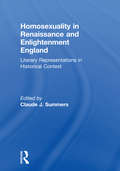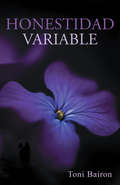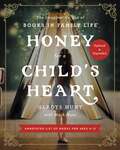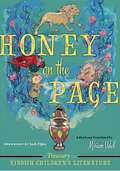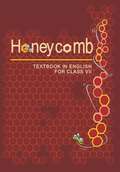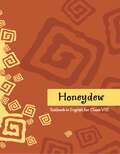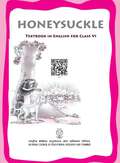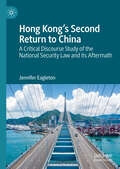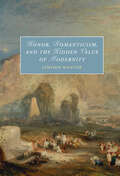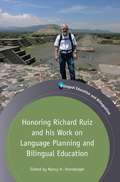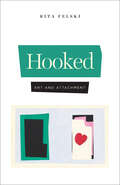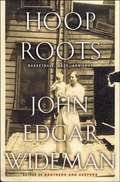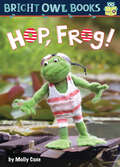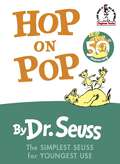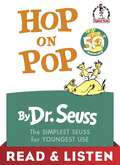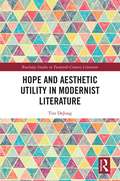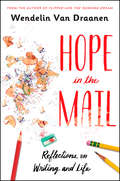- Table View
- List View
Homosexuality in Renaissance and Enlightenment England: Literary Representations in Historical Context
by Claude J SummersThis new book significantly contributes to an increased understanding of the gay and lesbian experience as it illuminates important works of literature and clarifies the status of same-sex desire in English literature from 1500--1760. Homosexual themes can be found throughout the literature of the English Renaissance and Enlightenment, but only rarely are they direct and unambiguous. The essays here are engaged in a vital and necessary process of re-historicizing and re-contextualizing literature. Utilizing a variety of critical methods and proceeding from several different theoretical and ideological presuppositions, these essays raise important questions about the methodology of gay studies, about the conception of same-sex desire, about the depiction of homoerotics, and about the relationship of sexuality and textuality, even as they shed new light on the homosexual import of a number of significant works of literature. Among the authors studied are Christopher Marlowe, William Shakespeare, John Donne, Lady Mary Wroth, Katherine Philips, Aphra Behn, John Cleland, and Thomas Gray. The collection attests both the current intellectual ferment in gay studies and the richness of English Renaissance and eighteenth-century literary representations of homosexuality.Homosexuality in Renaissance and Enlightenment England provides numerous insights into important works of literature and into significant theoretical issues implicit in the process of discerning and defining homosexuality in texts of earlier ages. All the contributors locate their texts in carefully delineated cultural and historical milieux. But they are not unduly constrained by either the tyranny of theory or the anxieties of anachronism. Rather than proceeding from hidebound or fashionably current ideologies, they sift the texts they study for the concrete evidence from which theories of sexuality might be constructed or modified. Hence, the collection will be valuable both for its practical criticism and for its theoretical contributions. It vividly illustrates the variety of gay studies in literature, especially as applied to works of earlier ages.
Homosexuality in the Life and Work of Joseph Conrad: Love Between the Lines (Studies in Major Literary Authors)
by Richard J. RuppelThis book analyzes the representations of homosexuality in Conrad’s fiction, beginning with Conrad’s life and letters to show that Conrad himself was, at least imaginatively, bisexual. Conrad’s recurrent bouts of neurasthenia, his difficult courtships, late marriage, and frequent expressions of misogyny can all be attributed to the fact that Conrad was emotionally, temperamentally, and, perhaps, even erotically more comfortable with men than women. Subsequent chapters trace Conrad’s fictional representations of homosexuality. Through his analysis, Ruppel reveals that homoeroticism is endemic to the adventure genre and how Conrad’s bachelor-narrators interest in younger men is homoerotic. Conrad scholars and those interested in homosexuality and constructions of masculinity should all be interested in this work.
Honestidad variable
by Toni BaironEl dietario de un cuarentón, un refugiado sentimental que busca asilo en el país de la literatura. Charles Bukowsky + E.M. Forster + Jaime Bayly = Toni Bairon <P><P>Honestidad variable es el dietario que escribe durante un año un padre de familia cuarentón que acaba de salir de un proceso de ansiedad, que acaba de sacar la cabeza del horno del más allá (regresiones hipnóticas, vida más allá de la vida), que está a punto de separarse, y que busca su espacio dentro de su propia familia, entre su mujer, sus tres hijos, el trabajo, la perrita, el tenis y los videojuegos. <P>Un padre de familia que al escribir este dietario encuentra una vía de escape, un refugio en la cima de una montaña que, aun estando sentado en la mesa del comedor, puede escalar con sólo ponerse unos auriculares con buena música de los años ochenta y noventa. <P>Con una prosa que aspira a tener el ligero gusto a cerveza barata de las páginas de Charles Bukowski, con un narcisismo de clase media que se reconoce vagamente en el narcisismo de clase alta de El canalla sentimental de Jaime Bayly, con una postal de Lord Byron luchando por la independencia de Grecia, con un título que homenajea la novela Nubosidad variable de Carmen Martin Gaite, con una avenida Meridiana contaminada por el espíritu victoriano de E.M. Forster, este dietario es su muleta para transitar por los cuarenta. <P>Suspendido en el vacío, sólo sujetado por las cuerdas de la guitarra de George Harrison en While my guitar gently weeps, nuestro padre de familia reflexiona sobre por qué siente la necesidad de escribir, por qué se lleva una libreta de tapas lilas al trabajo y algunos días se cierra en el coche a la hora de comer y escribe. <P>¿Se esconde? ¿Sueña con ser un Ken Follet de polígono? Nuestro padre de familia sólo sabe que las tapas lilas de la libreta son sus alas. Y el bolígrafo su guitarra eléctrica.
Honey for a Child's Heart Updated and Expanded: The Imaginative Use of Books in Family Life
by Gladys HuntA modern classic with over 250,000 copies sold, Honey for a Child's Heart is a compelling, essential guide for parents who want to find the best books for their children ages 0-12. This updated and expanded edition includes a new preface, an updated list of recommended reads for each age group, and audiobook suggestions.A good book is a gateway into a wider world of wonder, beauty, delight, and adventure. But children don't stumble onto the best books by themselves. They need a parent's help. Author Gladys Hunt, along with her son, Mark, discusses everything from how to choose good books for your children to encouraging them to be avid readers.Illustrated with drawings from dozens of children's favorites, Honey for a Child's Heart Updated and Expanded includes completely updated book lists geared to your child's age and filled with nearly one thousand longtime favorites, classics, wonderful new books, and audiobooks that will enrich your child's life. It will also show you how to:Understand the importance of being a read-aloud family, enjoying books together by reading aloudGive your children a large view of the world, of truth, and of goodnessEncourage each child's imagination and good use of languageFind the best books for your childrenThousands of parents have used this guide to furnish their children's inner spirit with the wonder and delight of good reading. Updated and expanded to keep pace with the ever-changing world of children's literature, it is sure to enrich the cultural and spiritual life of your home.
Honey on the Page: A Treasury of Yiddish Children's Literature
by Jack Zipes Isaac Metzker Moyshe Kulbak Kadya Molodowsky Sholem Asch David Rodin Yaakov Fichmann Yankev Pat Zina Rabinowitz Levin Kipnis Malka Szechet Mordkhe Spektor Rokhl Shabad Ida Maze Solomon Bastomski Jacob Reisfeder Judah Steinberg David Ignatov B. Alkvit Leon Elbe Benjamin Gutyanski Solomon Simon Der Tunkeler Leyb Kvitko Eliezer Shteynbarg Lit-Man Meyer Ziml Tkatch Moyshe Shifris Khaver Paver B. Oyerbakh Sarah LiebertWinner, 2021 Reference & Bibliography Award in the 'Reference' Section, given by the Association of Jewish LibrariesAn unprecedented treasury of Yiddish children’s stories and poems enhanced with original illustrationsWhile there has been a recent boom in Jewish literacy and learning within the US, few resources exist to enable American Jews to experience the rich primary sources of Yiddish culture. Stepping into this void, Miriam Udel has crafted an exquisite collection: Honey on the Page offers a feast of beguiling original translations of stories and poems for children. Arranged thematically—from school days to the holidays—the book takes readers from Jewish holidays and history to folktales and fables, from stories of humanistic ethics to multi-generational family sagas. Featuring many works that are appearing in English for the first time, and written by both prominent and lesser-known authors, this anthology spans the Yiddish-speaking globe—drawing from materials published in Eastern Europe, New York, and Latin America from the 1910s, during the interwar period, and up through the 1970s. With its vast scope, Honey on the Page offers a cornucopia of delights to families, individuals and educators seeking literature that speaks to Jewish children about their religious, cultural, and ethical heritage.Complemented by whimsical, humorous illustrations by Paula Cohen, an acclaimed children’s book illustrator, Udel’s evocative translations of Yiddish stories and poetry will delight young and older readers alike.
Honeycomb class 7 - NCERT - 23
by National Council of Educational Research and Training"Honeycomb," the class 7 English textbook by NCERT, is a captivating literary journey that immerses young readers in a diverse array of stories, poems, and plays. From the timeless quest for wisdom in "Three Questions" to the empathy imparted by a mischievous snake in "A Snake Charmer's Story," the book delves into themes of love, courage, and self-discovery. It showcases the spirit of adventure through characters like Gopal and his pursuit of a Hilsa fish, while encouraging scientific curiosity with the imaginative "Vita-Wonk." The text pays tribute to bravery in "A Homage to Our Brave Soldiers" and explores the beauty of nature in pieces like "Trees" and "Chivvy." Each chapter is meticulously designed to stimulate young imaginations, promote critical thinking, and instill a love for the English language, making "Honeycomb" an enriching and vibrant educational experience.
Honeydew class 8 - Himachal Pradesh Board
by Himachal Pradesh Board of School Education Dharamshala"Honeydew" is an English textbook for Class VIII, published by the Himachal Board of Education in collaboration with NCERT. It features a diverse selection of literary pieces, including poems, stories, and essays, curated to cater to the interests and comprehension levels of eighth-grade students. The book aims to enhance language skills, critical thinking, and literature appreciation through engaging content. Covering a wide range of themes such as social issues and moral dilemmas, "Honeydew" provides insights into the complexities of human experiences. Emphasizing vocabulary development, comprehension, and language proficiency, the textbook offers a comprehensive approach to English language learning tailored for students at this educational level.
Honeydew class 8 - NCERT - 23
by National Council of Educational Research and Training"Honeydew" is an English textbook designed for Class VIII students by NCERT. The book encompasses a diverse range of literary pieces, including poems, stories, and essays, carefully curated to cater to the varied interests and comprehension levels of eighth-grade learners. Through engaging and thought-provoking content, "Honeydew" aims to enhance students' language skills, critical thinking, and appreciation for literature. The curriculum covers a spectrum of themes, from social issues to moral dilemmas, offering students valuable insights into the complexities of human experiences. Additionally, the textbook places emphasis on developing vocabulary, comprehension, and language proficiency, fostering a holistic approach to English language learning for students at this educational level.
Honeysuckle class 6 - NCERT - 23
by National Council of Educational Research and Training"Honeysuckle" is an engaging English textbook for Class VI students by NCERT that offers a diverse collection of stories, poems, and prose aimed at developing language skills and nurturing creativity. The textbook presents a colorful array of literary pieces that cater to young readers' interests and learning levels. From enchanting tales like 'Who Did Patrick's Homework?' to inspiring poems like 'The Wonderful Words,' it covers themes of friendship, perseverance, nature, and imagination. Through relatable characters and vivid descriptions, it encourages students to explore their thoughts, expand their vocabulary, and enhance their comprehension skills. With a blend of entertaining narratives and thought-provoking content, "Honeysuckle" not only fosters language proficiency but also instills moral values and a love for literature in young minds, making it an essential and captivating resource in the academic journey of Class VI students.
Hong Kong's Second Return to China: A Critical Discourse Study of the National Security Law and its Aftermath
by Jennifer EagletonThis book is a cross-disciplinary study, incorporating political science, law, and sociolinguistics in its examination of Hong Kong&’s National Security Law which has impacted many aspects of life in the city. Through a critical discourse analysis lens, it details the lead-up to the Law&’s introduction in 2020, a textual analysis of the Law itself, the &“selling&” the Law to the public, the accompanying electoral changes, the effect on civil society, and the discourse of dissidents in exile. It ends with speculation on what the future will bring to the so-called &“One Country, Two Systems&” as it goes forward. The book caters for the general reader, the university student, and seasoned academic who want to be informed about the changes in Hong Kong as it transitions to be more &“fully China&”. The book ultimately argues that the &“One Country, Two Systems&” experimental framework had always been problematic from both a rhetorical and ideological perspective.
Honor Thy Gods
by Jon D. MikalsonIn Honor Thy Gods Jon Mikalson uses the tragedies of Aeschylus, Sophocles, and Euripides to explore popular religious beliefs and practices of Athenians in the fifth and fourth centuries B.C. and examines how these playwrights portrayed, manipulated, and otherwise represented popular religion in their plays. He discusses the central role of honor in ancient Athenian piety and shows that the values of popular piety are not only reflected but also reaffirmed in tragedies.Mikalson begins by examining what tragic characters and choruses have to say about the nature of the gods and their intervention in human affairs. Then, by tracing the fortunes of diverse characters -- among them Creon and Antigone, Ajax and Odysseus, Hippolytus, Pentheus, and even Athens and Troy -- he shows that in tragedy those who violate or challenge contemporary popular religious beliefs suffer, while those who support these beliefs are rewarded.The beliefs considered in Mikalson's analysis include Athenians' views on matters regarding asylum, the roles of guests and hosts, oaths, the various forms of divination, health and healing, sacrifice, pollution, the religious responsibilities of parents, children, and citizens, homicide, the dead, and the afterlife. After summarizing the vairous forms of piety and impiety related to these beliefs found in the tragedies, Mikalson isolates "honoring the gods" as the fundamental concept of Greek piety. He concludes by describing the different relationships of the three tragedians to the religion of their time and their audience, arguing that the tragedies of Euripides most consistently support the values of popular religion.
Honor, Romanticism, and the Hidden Value of Modernity (Cambridge Studies in Romanticism)
by Jamison KantorDespite our preconceptions, Romantic writers, artists, and philosophers did not think of honor as an archaic or regressive concept, but as a contemporary, even progressive value that operated as a counterpoint to freedom, a well-known preoccupation of the period's literature. Focusing on texts by William Godwin, William Wordsworth, Jane Austen, Walter Scott, Mary Prince, and Mary Seacole, this book argues that the revitalization of honor in the first half of the nineteenth century signalled a crisis in the emerging liberal order, one with which we still wrestle today: how can political subjects demand real, materialist forms of dignity in a system dedicated to an abstract, and often impoverished, idea of 'liberty'? Honor, Romanticism, and the Hidden Value of Modernity presents both a theory and a history of this question in the media of the Black Atlantic, the Jacobin novel, the landscape poem, and the “financial” romance.
Honor, Vengeance, and Social Trouble: Pardon Letters in the Burgundian Low Countries
by Walter Prevenier Peter ArnadeAmong the more intriguing documentary sources from late medieval Europe are pardon letters--petitions sent by those condemned for serious crimes to monarchs and princes in France and the Low Countries in the hopes of receiving a full pardon. The fifteenth-century Burgundian Low Countries and duchy of Burgundy produced a large cache of these petitions, from both major cities (Bruges, Ghent, Antwerp, and Dijon) and rural communities. In Honor, Vengeance, and Social Trouble, Peter Arnade and Walter Prevenier present the first study in English of these letters to explore and interrogate the boundaries between these sources' internal, discursive properties and the social world beyond the written text.Honor, Vengeance, and Social Trouble takes the reader out onto the streets and into the taverns, homes, and workplaces of the Burgundian territories, charting the most pressing social concerns of the day: everything from family disputes and vendettas to marital infidelity and property conflicts--and, more generally, the problems of public violence, abduction and rape, and the role of honor and revenge in adjudicating disputes. Arnade and Prevenier examine why the right to pardon was often enacted by the Burgundian dukes and how it came to compete with more traditional legal means of resolving disputes. In addition, they consider the pardon letter as a historical source, highlighting the limitations and pitfalls of relying on documents that are, by their very nature, narratives shaped by the petitioner to seek a favored outcome. The book also includes a detailed case study of a female actress turned prostitute. An example of microhistory at its best, Honor, Vengeance, and Social Trouble will challenge scholars while being accessible to students in courses on medieval and early modern Europe or on historiography.
Honoring Richard Ruiz and his Work on Language Planning and Bilingual Education
by Nancy H. HornbergerRichard Ruiz has inspired generations of scholars in language planning and multilingual education with his unique orientations to language as a problem, a right and a resource. This volume attests to the far-reaching impact of his thinking and teaching, bringing together a selection of his published and unpublished writings on language planning orientations, bilingual and language minority education, language threat and endangerment, voice and empowerment, and even language fun, accompanied by contributions from colleagues and former students reflecting and expanding on Ruiz' ground-breaking work. This book will be of great interest to both undergraduate and postgraduate students in language planning and multilingual education, Indigenous and minority education, as well as to junior and senior researchers in those fields.
Honrarás a tu padre
by Gay TaleseEl primer libro de no ficción que desveló los secretos de la Mafia y puso en jaque la vida de su autor, quien viajó a Sicilia y se infiltró en la intimidad de los Bonanno durante seis años. Una lluviosa noche de octubre de 1964, dos gánsteres secuestraron al famoso jefe mafioso Joseph Bonanno. A la mañana siguiente la policía neoyorquina informaba de su muerte. Un año después, Bonanno reapareció de forma misteriosa, y su vuelta desató una sangrienta disputa entre familias de la mafia. Esta obra monumental, que se lee como una trepidante novela «llena de detalles íntimos y fruto de una brillante labor periodística», se convirtió en un bestseller desde su publicación en 1971, fue llevada a la pantalla televisiva en miniseries de la CBS e incluso serviría de inspiración para crear Los Soprano. Ningún otro libro ha contribuido tanto a desvelar los secretos, la estructura, las guerras, las luchas de poder, las vidas familiares y las personalidades fascinantes y aterradoras de la mafia. Reseñas:«Un documento de un valor incalculable.»Wilfrid Sheed, The New York Review of Books «Brillante... Indispensable.»Robert Kirsch, Los Ángeles Times
Hooked: Art and Attachment
by Rita Felski“Examines the way we connect to novels, films, paintings and music, and argues that our enthusiasms should be an integral part of conversations about art.” —Helen Thaventhiran, London Review of BooksHow does a novel entice or enlist us? How does a song surprise or seduce us? Why do we bristle when a friend belittles a book we love, or fall into a funk when a favored TV series comes to an end? What characterizes the aesthetic experiences of feeling captivated by works of art? In Hooked, Rita Felski challenges the ethos of critical aloofness that is a part of modern intellectuals’ self-image. The result is sure to be as widely read as Felski’s book, The Limits of Critique.Wresting the language of affinity away from accusations of sticky sentiment and manipulative marketing, Felski argues that “being hooked” is as fundamental to the appreciation of high art as to the enjoyment of popular culture. Hooked zeroes in on three attachment devices that connect audiences to works of art: identification, attunement, and interpretation. Drawing on examples from literature, film, music, and painting—from Joni Mitchell to Matisse, from Thomas Bernhard to Thelma and Louise—Felski brings the language of attachment into the academy. Hooked returns us to the fundamentals of aesthetic experience, showing that the social meanings of artworks are generated not just by critics, but also by the responses of captivated audiences.“[Hooked] is an exposé aimed at critics who disavow their personal allegiances.” —Matthew Rubery, Public Books“There are many insights in Hooked that will facilitate a productive interdisciplinary conversation about aesthetics, politics, and the future of critique.” —Michael Gallope, nonsite.org
Hooked: Write Fiction That Grabs Readers at Page One & Never Lets Them Go
by Les EdgertonAgents and editors agree; Improper story beginnings are the single biggest barrier to publication.
Hoop Roots
by John Edgar WidemanWhile presenting a memoir of discovering basketball, novelist Wideman (U. of Massachusetts-Amherst) reveals much about the origins of black basketball in the US.
Hop Frog (Bright Owl Books)
by Molly CoxeFrog helps Fox and Ox and Pollywog. But who will help Frog? This fun photographic easy-to-read story features the short "o" vowel sound. Kane Press's new series of super simple easy-to-reads, Bright Owl Books, launches with Molly Coxe's five photographic stories, which feature the short vowel sounds and are each only around 100 words. These irresistibly silly stories help kids learn to read through repetition and by teaching the basic building blocks of reading—vowel sounds—giving kids the perfect start on educational success.
Hop on Pop (Beginner Books(R))
by Dr. SeussJoin Dr. Seuss in this classic rhyming picture book–"the simplest Seuss for youngest use." Full of short, simple words and silly rhymes, this book is perfect for reading alone or reading aloud with Dad! The rollicking rythym will keep kids entertained on every page, and it's an especially good way to show Pop some love on Father&’s Day! HOP POP We like to Hop. We like to hop on top of Pop. Originally created by Dr. Seuss himself, Beginner Books are fun, funny, and easy to read. These unjacketed hardcover early readers encourage children to read all on their own, using simple words and illustrations. Smaller than the classic large format Seuss picture books like The Lorax and Oh, The Places You&’ll Go!, these portable packages are perfect for practicing readers ages 3-7, and lucky parents too!
Hop on Pop: Read & Listen Edition (Beginner Books(R))
by Dr. SeussLoved by generations, this &“simplest Seuss for youngest use&” is a Beginner Book classic. See Red and Ned and Ted and Ed in a bed. And giggle as Pat sits on a hat and on a cat and on a bat . . . but a cactus? Pat must NOT sit on that! This classic Beginner Book makes an ideal gift for Seuss fans and is an especially good way to show Pop some love on Father&’s Day!Originally created by Dr. Seuss, Beginner Books encourage children to read all by themselves, with simple words and illustrations that give clues to their meaning. This Read & Listen edition contains audio narration.
Hope and Aesthetic Utility in Modernist Literature (Routledge Studies in Twentieth-Century Literature)
by Tim DeJong"Hope" and "modernism" are two words that are not commonly linked. Moving from much-discussed negative affects to positive forms of feeling, Hope and Aesthetic Utility in Modernist Literature argues that they should be. This book contends that much of modernist writing and thought reveals a deeply held confidence about the future, one premised on the social power of art itself. In chapters ranging across a diverse array of canonical writers – Henry James, D.W. Griffith, H.D., Melvin Tolson, and Samuel Beckett – this text locates in their works an optimism linked by a common faith in the necessity of artistic practice for cultural survival. In this way, the famously self-attentive nature of modernism becomes a means, for its central thinkers and artists, of reflecting on what DeJong calls aesthetic utility: the unpredictable, ungovernable capacity of the work of art to shape the future even while envisioning it.
Hope at Sea: Possible Ecologies in Oceanic Literature
by Teresa ShewryAs far back as Thomas More&’s Utopia and Francis Bacon&’s New Atlantis, the Pacific Ocean has inspired literary creations of promising worlds. Hope at Sea asks how literary writers have more recently conceived the future of ocean living. In doing so, it provides a new perspective on art and imagination in the face of enormous environmental change.Drawing together ecocriticism, theories of hope, and literary analysis, this book explores how literary writers evoke hope in engaging with environmental upheavals that are reshaping life in the Pacific Ocean. Teresa Shewry considers contemporary poetry, short stories, novels, art, and journalistic pieces from Australia, New Zealand, Hawai&’i, and other ocean sites, examining their imaginative accounts of present life and future living in places where humans coexist with environmental loss: rivers that no longer reach the sea, dwindling populations of ocean life, the effects of nuclear weapons testing, and more. These works are connected by their views of a future that includes hope.Until now, hope has never been theorized in a direct, sustained way in ecocriticism. Hope at Sea makes an argument for hope as a lens for creative and critical confrontation with environmental disruptions and the resulting sense of loss. It also reflects on the critical approaches that hope as an analytic category opens up for the study of environmental literature.With hope as a critical perspective, Shewry develops a method for reading environmental literature: literary writers create new ways to apprehend existing environmental realities and craft stories about seas, forests, cities, and rivers that could be—not as literal plans but as ways of imagining promising lives in the present world and in the world to come.
Hope in the Mail: Reflections on Writing and Life
by Wendelin Van DraanenPart writing guide and part memoir, this inspiring book from the author of Flipped and The Running Dream is like Bird by Bird for YA readers and writers. <p><p> Wendelin Van Draanen didn't grow up wanting to be a writer, but thirty books later, she's convinced that writing saved her life. Or, at least, saved her from a life of bitterness and despair. Writing helped her sort out what she thought and felt and wanted. And digging deep into fictional characters helped her understand the real people in her life better as well. <p> Wendelin shares what she's learned--about writing, life, and what it takes to live the writing life. This book is packed with practical advice on the craft: about how to create characters and plot a story that's exciting to read. But maybe even more helpful is the insight she provides into the persistence, and perseverance, it takes to live a productive, creative life. And she answers the age-old question Where do you get your ideas? by revealing how events in her own life became the seeds of her best-loved novels.Hope in the Mail is a wildly inspirational read for anyone with a story to share.
Hope: A Literary History
by Adam PotkayHope for us has a positive connotation. Yet it was criticized in classical antiquity as a distraction from the present moment, as the occasion for irrational and self-destructive thinking, and as a presumption against the gods. To what extent do arguments against hope today remain useful? If hope sounds to us like a good thing, that reaction stems from a progressive political tradition grounded in the French Revolution, aspects of Romantic literature and the influence of the Abrahamic faiths. Ranging both wide and deep, Adam Potkay examines the cases for and against hope found in literature from antiquity to the present. Drawing imaginatively on several fields and creatively juxtaposing poetry, drama, and novels alongside philosophy, theology and political theory, the author brings continually fresh insights to a subject of perennial interest. This is a bold and illuminating new treatment of a long-running literary debate as complex as it is compelling.
